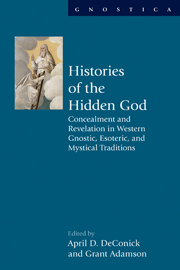 Histories of the Hidden God
Histories of the Hidden God Book contents
- Frontmatter
- Contents
- Acknowledgments
- Contributors
- Introduction: In search of the hidden God
- Part I Concealment of the Hidden God
- Part II The Human Quest for the Hidden God
- 6 Obscured by the scriptures, revealed by the prophets: God in the Pseudo-Clementine Homilies
- 7 How hidden was God? Revelation and pedagogy in ancient and medieval Hermetic writings
- 8 From hidden to revealed in Sethian revelation, ritual, and protology
- 9 Shamanism and the hidden history of modern Kabbalah
- 10 Dreaming of paradise: Seeing the hidden God in Islam
- Part III Revelations of the Hidden God
- Afterword: Mysticism, Gnosticism, and esotericism as entangled discourses
- Bibliography
- Index
6 - Obscured by the scriptures, revealed by the prophets: God in the Pseudo-Clementine Homilies
from Part II - The Human Quest for the Hidden God
- Frontmatter
- Contents
- Acknowledgments
- Contributors
- Introduction: In search of the hidden God
- Part I Concealment of the Hidden God
- Part II The Human Quest for the Hidden God
- 6 Obscured by the scriptures, revealed by the prophets: God in the Pseudo-Clementine Homilies
- 7 How hidden was God? Revelation and pedagogy in ancient and medieval Hermetic writings
- 8 From hidden to revealed in Sethian revelation, ritual, and protology
- 9 Shamanism and the hidden history of modern Kabbalah
- 10 Dreaming of paradise: Seeing the hidden God in Islam
- Part III Revelations of the Hidden God
- Afterword: Mysticism, Gnosticism, and esotericism as entangled discourses
- Bibliography
- Index
Summary
One of the works associated with Clement, a romance known as the Homilies, suggests that the teaching of Jesus who is the True Prophet and books of Peter's preaching reveal the authentic nature of God which Scripture, in fact, obscures. These striking views illumine a community behind the Pseudo-Clementine writings that has been largely lost to contemporary audiences and a perspective on the divine that we attempt to excavate through this essay. While there are other writings associated with (Pseudo-)Clement that are indebted to common sources and share key themes, we restrict our investigation of the depiction of God to the Homilies; this romance's distinctive views on Scripture and prophecy influence how the Homilies understand the divine as both concealed and revealed.
Pseudo-Clementine literature challenges our impulse to define late antique religious texts according to the heuristic categories to which we may have become accustomed; when it comes to situating the Pseudo-Clementines, we are at a loss as to how we might locate these fascinating and rich texts amid the religious landscape of late antiquity. The Pseudo-Clementines, primarily associated with fourth century Syria, have been described simultaneously as “Jewish-Christian,” “Gnostic,” and “orthodox,” however uncertain or ill-defined such designations and posited communities are. It should be no surprise, then, that the portrait of God to emerge from these writings is equally complex. For example, the deity that emerges from the Pseudo-Clementines recalls the God of the Hebrew scriptures and yet the latter writings are said to misrepresent the divine through falsehoods.
- Type
- Chapter
- Information
- Histories of the Hidden GodConcealment and Revelation in Western Gnostic, Esoteric, and Mystical Traditions, pp. 120 - 136Publisher: Acumen PublishingPrint publication year: 2013
